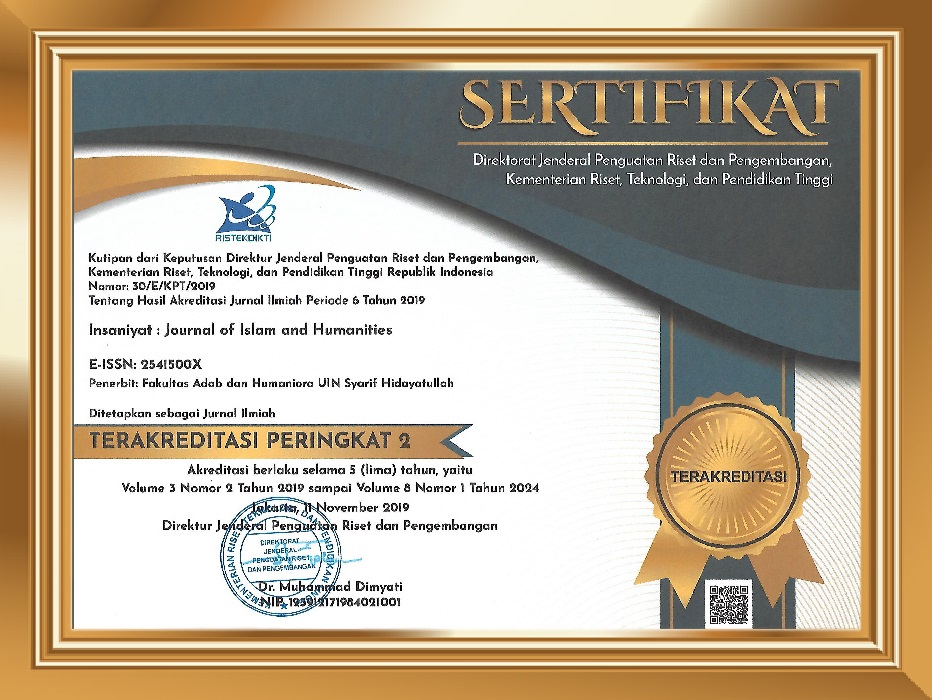Becoming Indonesia: Political Gait of the Arabs in the Pre-Independence Period
Abstract
This article addresses the political gait of the Arabs in Pre-Independence Indonesia. Using a qualitative method with a historical approach, this article aims to parse the political role of Arabs in Indonesia, the achievements they have, and the challenges they have faced since they first came to Indonesia until the country became independent in 1945. This study identifies several things. First, the involvement of Arabs in Indonesian politics has been going on since the time of the kingdom or empire. Some Sayyids are believed to occupy important positions, such as advisors to the king, foreign diplomats, and ministers. Second, in modern times, primarily until 1945, Arabs, both individually and in groups, have played an essential role in the constellation of Indonesian politics. In addition to establishing and developing PAI (called the Indonesian Arab Association initially but changed to the Indonesian Arab Party) in 1934, its figures, especially A.R. Baswedan and Hamid Algadri, were among the prominent figures during the Indonesian independence process. Third, there was a change in tendency in which the Arabs no longer struggled with aspects of the trade, as their initial motivation to emigrate to the archipelago, but began to be involved in various spheres of Indonesian people's lives, including in state politics. They have become essential figures of Indonesian society. With the political role played, they gain a stronger identity, increasingly 'becoming Indonesia'.
Keywords
References
Abshouk, A. I., & Ibrahim, H. A. (2009). The Hadhrami Diaspora in Southeast Asia: Identity Maintenance or Assimilation? Brill.
Alatas, I. F. (2016). The Pangeran and the Saints: The Historical Inflection of a Mid 19th-Century Ḥaḍramī Mausoleum in East Java, Indonesia. Journal Indonesian and the Malay World, 44(130).
Algadri, Hamid. (1991). Suka Duka Masa Revolusi. UI Press.
Algadri, Hamid. (1996). Islam dan Keturunan Arab dalam Pemberontakan melawan Belanda. Mizan.
Amaruli, R. J., Maulany, N. N., & Sulistiyono, S. T. (2018). Sumpah Pemuda Arab, 1934: Pergulatan Identitas Orang Arab-Hadrami di Indonesia. Jurnal Sejarah Citra Lekha, 3(2), 122–132.
Arai, K. (2004). Arabs who Traversed the Indian Ocean: The history of the al -’Attas Family in Hadramawt and Southeast Asia, C.1600-C.1960. University of Michigan.
Arnold, T. W. S. (1913). The Preaching of Islam: A History of the Propagation of the Muslim Faith. London Constable.
Azra, A. (2002). Islam Nusantara: Jaringan Ulama Global dan Lokal. Mizan.
Basundoro, P. (2012). A.R Baswedan: Dari Ampel ke Indonesia. Jurnal Lakon, 1(1).
Berg, L. W. C. V. den. (2010). Orang Arab di Nusantara. Komunitas Bambu.
Hasjmy, A. (1981). Sejarah Masuk dan Berkembangnya Islam di Indonesia. Al-Ma’arif.
Hidayah, Z. (1997). Ensiklopedi Suku bangsa di Indonesia. LP3ES.
Hodgson, M. G. S. (1977). The Venture of Islam: The Classical Age of Islam. University of Chicago Press.
Hosniyah. (2016). Kebijakan Pemerintah Hindia Belanda Terhadap Komunitas Arab di Malang 1900-1935. Avatara E-Journal Pendidikan Sejarah, 4(3).
Jacobsen, F. F. (2009). Hadrami Arabs in Present-day Indonesia: An Indonesia-Oriented Group with an Arab Signature. Routledge.
Kaptein, N. J. G. (2014). Islam, Colonialism and the Modern Age in the Netherlands East Indies: A Biography of Sayyid Uthman 1822-1914. Brills.
Korver, A. (1985). Sarekat Islam: Gerakan Ratu Adil? Grafiti Pres.
Leur, J. C. V. (1960). Indonesia Trade and Society: Essays in Asian Social and Economic History (2 ed.). Sumur Bandung.
Locher-Scholten, E. (2004). Sumatran Sultanate and Colonial State: Jambi and the Rise of Dutch Imperialism 1830–1907. Cornell University Press.
Lombard, D., & Salmon, C. (1994). Islam and Chineseness,” Indonesia 57.
Maryam, L. (2018). Perjuangan Hamid Algadri pada Masa Pergerakan dan Pasca Kemerdekaan 1934-1950. UIN Syarif Hidayatullah Jakarta.
Mobini-Kesheh, N. (1999). The Hadrami Awakening: Community and Identity in the Netherlands East Indies, 1900-1942. Cornell University Press.
Pijiper, G. F. (1985). Beberapa Studi tentang Sejarah Islam di Indonesia 1900-1950. UI Press.
Reid, A. (1972). Habib Abdur Rahman Az-Zahir 1833–1896.
Schmidt, J. (2003). Pan-Islamisme di Antara Porte, Den Haag dan Buitenzorg”, dalam Kaptein, Nico J. G. (ed.), Kekacauan dan Kerusuhan: Tiga Tulisan tentang PanIslamisme di Hindia-Belanda Timur pada Akhir Abad Kesembilan Belas dan Awal Abad Kedua. INIS.
Subchi, I. (2019). The History of Hadrami Arabic Community Development in Southeast Asia. Episteme: Jurnal Pengembangan Ilmu Keislaman, 14(2), 234–235.
Supratman, F. R. (2016). Before The Ethical Policy The Ottoman State, Pan-Islamism, and Modernisation in Indonesia 1898–1901. Al-Jāmi‘ah: Journal of Islamic Studies, 54(2), 458.
Suratmi, & Kwartanada. (2014). Biografi A.R.Baswedan. Membangun Bangsa Merajut Keindonesiaan. Kompas Media Nusantara.
Suratmin, & Kwartanada. (2014). Biografi Abdul Rahman Baswedan: Membangun Bangsa Merajut Keindonesiaan. Kompas Media Nusantara.
Tagliacozzo, E. (2009). Southeast Asia and the Middle East: Islam, Movement, and the Longue Duree. NUS Press.
Wahyudi, J., & Madjid, D. (2019). Pekojan: Image of an Arab Kampong during XVIII to XIX Centuries Batavia. Insaniyat Journal of Islam and Humanities, 3(2).
Wolter, O. W. (1967). Early Indonesian Commerce: A Study of the Origins of Srivijaya. Cornell University Press.
Yegar, M., & Schumacher, Y. (2012). Mutual Affinities: Islam in Southeast Asia and the Arab World. 6(1), 73–89.
DOI: 10.15408/insaniyat.v4i2.15229
Refbacks
- There are currently no refbacks.






